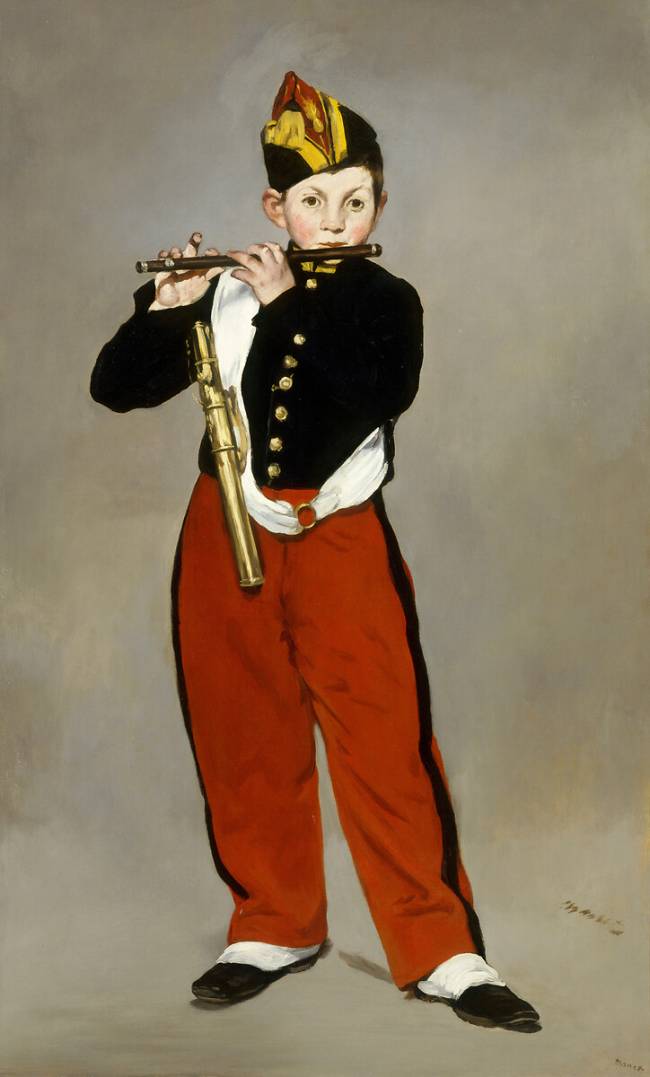Shop art print and framed art The Fifer by Edouard Manet
Customise
Your art print
The Fifer OF Edouard Manet
The Fifer
The creative context of Édouard Manet's Fifre: an artist in search of renewal
Painted in 1866 by Édouard Manet, Le Fifre is a painting that marks the beginning of the modern period of art. Created during the period when painting was dominated by Romantic and Realist styles,Édouard Manet, with his avant-garde style, then brought a new artistic vision when it was presented at the Paris Salon in 1866.
With this painting, now in the Musée d'Orsay in Paris, Manet, breaking with convention, sought to break with traditional codes and express his view of society in an innovative and daring way. He drew inspiration from the Old Masters, particularly Velázquez, but also from Japanese art, which was in vogue in Paris at the time. The choice of subject (a young boy playing a drum) and the way it is depicted bear witness to these preoccupations. It is an ordinary scene, but treated with a modernity and simplicity that contrast with contemporary academic paintings. With this painting, Manet thus paved the way for the Impressionist movement.
Edouard Manet's Le Fifre: A portrait where simplicity serves expressiveness
In this 161 x 97 cm oil on canvas, the main subject is a young full-length musician, dressed in the bright uniform of the Imperial Guard's enfants de troupe. The neutral, bluish-grey background isolates the figure and focuses attention on him, and the light, coming mainly from the left, accentuates the effect of realism and brings out the boy's volume and intense presence in the pictorial space. The composition is simple, almost austere, but the fife's slightly swaying pose, facing the viewer, gives it a striking presence, reinforcing the character's impact. The bright, contrasting colours reinforce this impression of vitality.
In terms of form, Manet adopted a simplified, synthetic approach, favouring sharp contours and flat areas of colour rather than gradations or material effects. However, he demonstrates great mastery in the representation of volumes (the pleating of the clothes, the roundness of the young boy's cheeks) and in the precision of small details such as the gold buttons on the uniform.
The space depicted is also very bare: there is no perspective, no vanishing lines, simply a monochrome background that highlights the main subject. This absence of context encourages a direct and immediate reading of the painting, without concession or artifice.
The central subject of Édouard Manet's Fifre
The young fife, whose identity remains unknown, is the absolute protagonist of the work. His face, serious and concentrated, contrasts with the gaiety of his uniform. He seems absorbed in his game, indifferent to the viewer's gaze. Manet paid great attention to detail: the gold buttons on his jacket, the braid on his trousers, the case on his fife. These elements, rendered with precision, anchor the character in reality, while underlining the decorative dimension of the work.
A turning point in art history: the legacy of Édouard Manet's Fifre
Le Fifre elicited contrasting reactions when it was presented at the Salon of 1866. Critics, accustomed to historical and mythological subjects, denounced the banality of the subject and the boldness of the workmanship. But a few voices were raised in Manet's defence, notably Émile Zola, who praised his talent and modernity. Today, Le Fifre is considered a major work of Impressionism, a manifesto of modern painting. It paved the way for new forms of artistic expression, freed from academic constraints. Manet, by painting this anonymous young musician, thus gave birth to an icon of modernity.
This artwork is a painting from the classical period. It belongs to the impressionism style.
« The Fifer » is kept at Musee d'Orsay, Paris, France.
Find the full description of The Fifer by Edouard Manet on Wikipedia.



































